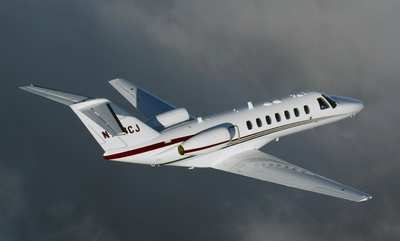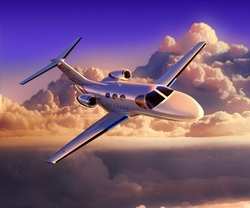Also Says Mustang Cert Right On Track
 At this year's
International Air Show in Farnborough, England, Cessna Aircraft
Company announced it received European Aviation Safety Agency
(EASA) certification for the Citation CJ1+ March 13, the Citation
CJ2+ July 10 and the Citation CJ3 June 16 -- allowing all of the CJ
series aircraft to be certified and registered within the 25
European countries adhering to EASA regulations. EASA certification
also allows operators to obtain European registrations.
At this year's
International Air Show in Farnborough, England, Cessna Aircraft
Company announced it received European Aviation Safety Agency
(EASA) certification for the Citation CJ1+ March 13, the Citation
CJ2+ July 10 and the Citation CJ3 June 16 -- allowing all of the CJ
series aircraft to be certified and registered within the 25
European countries adhering to EASA regulations. EASA certification
also allows operators to obtain European registrations.
There are more than 900 airplanes in the CJ fleet with more than
1.3 million flight hours. Cessna says Europe, the Middle East and
Africa are the largest markets for the CJ series, after the United
States.

Cessna also took the opportunity to share news on the progress
of the next Citation jet slated to join the lineup: the Citation
Mustang VLJ.
With more than 1,400 total flight hours and more than 850
flights accumulated by the three Citation Mustangs flying in Cessna
Aircraft Company's certification program, Cessna reports the
Citation Mustang remains on track for Federal Aviation
Administration certification later this year and European Aviation
Safety Agency certification in second quarter 2007.
 To date, Cessna has
subjected Mustang airframes to the equivalent of five lifetimes of
structural fatigue testing, qualifying it as a no-life-limit
airframe.
To date, Cessna has
subjected Mustang airframes to the equivalent of five lifetimes of
structural fatigue testing, qualifying it as a no-life-limit
airframe.
"Cessna consistently goes beyond what is required when testing
and certifying an aircraft, often more than doubling or tripling
the hours or cycles considered baseline for certification," said
Russ Meyer III, Citation Mustang Program Manager. "For example,
instead of the fatigue test article completing the baseline
durability test of two lifetimes (30,000 hours) with no damage to
the aircraft structure, we will continue testing to five lifetimes
(75,000 hours). Many parts of the aircraft are tested to the same
levels as commercial airliners. Ensuring Cessna customers have the
safest possible aircraft is always our top priority."
Cessna reports that FAA certification tests that have been
completed include:
- Flight envelope expansion to maximum airspeeds
- Aircraft stability and control
- Environmental chamber testing (from -40 degrees to 120 degrees
Fahrenheit)
- Autopilot certification
- Climb certification
FAA certification tests in progress include:
- Natural icing (flight into known icing)
- Garmin G1000 avionics
- Aircraft performance
- Engine handling and operation
More than 3,100 hours have been accumulated on the Mustang's
Pratt & Whitney Canada PW615F dual-channel FADEC engine.
Pre-certification development is complete on the engines. The
engine has been certified in Canada.

Additionally, static testing is more than 95 percent complete,
and the main landing gear surpassed its goal of 75,000 landings,
reaching more than 100,000 landings. The nose landing gear has
45,000 landings out of 75,000.
Cessna has also completed structural fatigue testing, with
75,000 aircraft cycles.
With nearly 250 orders, the Mustang is sold out into the third
quarter of 2009. Currently, about 60 percent of Mustang orders are
from outside of the United States, with 30 percent from Europe.
Other significant markets include South America and Australia.

Fifteen Mustangs are currently on the production line in
Independence, KS. The first flight of the fourth Mustang occurred
June 15, two weeks ahead of schedule. This jet will enter service
as a marketing demonstration aircraft later this year.
The Citation Mustang program was announced in September 2002.
The six-seat business jet will be certified as a FAR Part 23
aircraft, with a cruise speed of 340 KTAS and maximum operating
altitude of 41,000 feet.
 ANN's Daily Aero-Linx (05.02.24)
ANN's Daily Aero-Linx (05.02.24) ANN's Daily Aero-Term (05.02.24): Touchdown Zone Lighting
ANN's Daily Aero-Term (05.02.24): Touchdown Zone Lighting Aero-News: Quote of the Day (05.02.24)
Aero-News: Quote of the Day (05.02.24) ANN FAQ: Contributing To Aero-TV
ANN FAQ: Contributing To Aero-TV NTSB Final Report: Cirrus Design Corp SR20
NTSB Final Report: Cirrus Design Corp SR20







